Athlete Profile: Lindsay Jennerich
September 7, 2011
Canadian Lightweight rower on training with Mike Spracklen,
breaking stereotypes, and pulling together when it matters the most
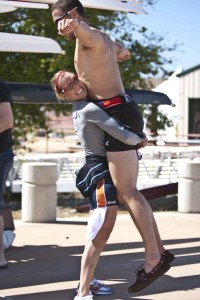
Canadian lightweight Lindsay Jennerich hoists heavyweight Rob Gibson (Photo Kevin Light)
By Yasemin Watkins for Coach Kaehler
Need a little inspiration? Feel like you’re fighting the odds?
Read on, because according to Canadian lightweight rower, 2010 world champion and 2011 world silver medalist, Lindsay Jennerich, it’s all about one thing, “Belief in what you’re doing. Knowing you’ve done everything you can to win.”
Sounds simple enough, but Jennerich – her philosophy and approach to training — make her both perplexing and intriguing at the same time.
To many, she’s a head-scratcher.
Just when you think you’ve checked all the competition, read all the results, facts and figures. Just when you’ve spoken to all the people “in-the-know,” stacked and weighed all the conditions. Just when you think you’ve got it all figured out, she comes out and pulls a fast one.
In this case, a really fast one.
A final and powerful sprint secured her boat for the 2012 London Olympics, and propelled her and her partner to a silver medal finish at the 2011 World Rowing Championships.
That’s Lindsay Jennerich I’m talking about.
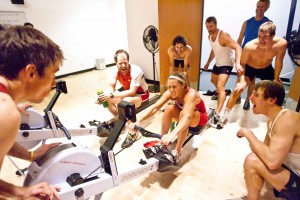
Three Stroke Max: Breaking 500 watts with a little help from some friends. (Photo Kevin Light) Front of erg - Malcolm Howard, Back Row - Cam Sylvester, Fraser Berkhout, Gabe Bergen, Doug Csima, James Dunaway (sitting) and Steven Van Knotsenberg
The 5’5” Canadian power-house, together with her super-subbing partner, Patricia Obee, took second place in the women’s lightweight doubles (LW2X) event at the 2011 World Rowing Championships in Bled, Slovenia. Although Jennerich was the reigning world champion (with partner Tracy Cameron), this outcome was not what the experts had predicted.
With 2012 Olympic boat qualifications on the line, the recently-held Championships were the most important event of the 2011 racing schedule. Athletes hope and pray that their endless hours of erging, rowing, conditioning and sacrifice set them up for peak performance at this most crucial event, when competition is at its pre-Olympic best.
At the lead-up world cup event in Lucerne, Switzerland, Jennerich and Cameron won the LW2X and looked poised to successfully defend their world championship title only weeks away.
A rib injury, however, sidelined Cameron from the LW2X and temporarily altered the script.
To help Jennerich qualify the LW2X boat for the 2012 Olympics, and then defend her world title, Rowing Canada shifted the boating assignments. They placed Cameron in the LW1X (a non-Olympic event) where she placed a respectable 6th, and paired Patricia Obee with Jennerich for the more important LW2X event.
Cameron’s substitute, Obee, is an equally logic-defying 5’4” lightweight rower. At the tender age of 19, she’s already seen her share of international success (3rd in the LW1X at the 2011 U23 World Championships; 8th in the LW1X at the 2011 Lucerne World Cup; 3rd in the W8+ at the 2010 U23 World Championships). Obee trains with Jennerich in Victoria, B.C.
Qualifying for Olympic events is no easy task, even for reigning world champions. And having only 4 weeks to ‘gel’ with a new partner, didn’t weigh the odds in the Canadians’ favor.
Jennerich’s response to the monumental pressure?
“Just another race as the underdog,” she tweeted at the onset of Bled racing. “I love it!”
Not the reaction of your average athlete. But then, Jennerich is not average. Not even close.
To understand Jennerich’s “amped” psyche, you have to understand a little about her background and less-than-conventional approach to training.
First, she’s smaller than most world-class rowers. Openweight women average about 6’ tall; lightweights about 5’8”. Jennerich’s stands 5’5”, more in line with “coxswains” – or smaller crew-members who sit in the stern and guide the boat. Frustrated at being “constantly overlooked” by her college coaches because of her size, Jennerich shed a few pounds and started rowing as a lightweight. A definite step in the right direction.
Second, for most of the year, Jennerich trains thousands of miles away from her sculling partner, Cameron, who is based in London, Ontario. Jennerich explains that in London, “the water freezes over and there is too much time on the erg.” In the winter, she prefers instead to split her time training on the water and indoors on the erg.
“Tracy supports my decision to train in B.C.” says Jennerich. “She feels as strongly about training in London as I feel about Victoria.”
“It’s all about belief in what you’re doing,” says Jennerich. “Feeling like you’ve done everything you can to win.”
From Cameron’s point of view, she agrees that training apart in the winter months and early in the Olympic cycle is “not necessarily a bad thing.”
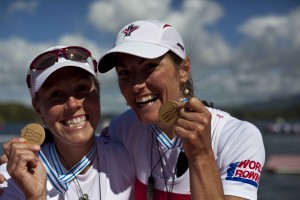
2010 LW2X world champions Lindsay Jennerich and Tracy Cameron (Photo Kevin Light)
“Lindsay and I are both mature athletes who know how to maximize our training regardless of the environment that we’re in,” says Cameron. “In Victoria, she has a great support system – her family, her boyfriend, and a great training group. These things alone can help improve performance. “
“When we come together, it can take a few weeks to gel or blend our individual styles to sync into the double,” adds Cameron. “But once we’ve had that initial time together, we really start to connect. We both understand where boat speed can be found, and we have the same understanding of how to find that speed together. I think that’s why we can sync into each other’s rhythm so quickly.”
Bottom line: they’re both committed to the same goal.
“The Olympic gold medal is what we’re after,” says Cameron. “We’ll do whatever it takes to improve our performance over the next 11 months.”
This brings us to the third point. For Jennerich, “whatever it takes” means training with the men instead of the women — the heavyweight men to be exact, along with their legendary coach Mike Spracklen. Currently Jennerich and Obee are the only two women who train with Spracklen and his men.
Unconventional? Yes.
How do the men feel about having lightweight women training with them? I asked Kevin Light (2008 Olympic Champion, men’s 8+) for his perspective on training with Jennerich.
“Lindsay brings the same qualities as any athlete who has success in the Mike Spracklen program. The main one being hard work,” says Light who is currently training toward the 2012 Olympics. “Mike respects athletes who try to achieve their maximum potential – male or female.”
“Personally, it’s much better to have someone like Lindsay who is always pushing to get better, than a male athlete who is happy just toeing the line and taking up space.”
Light compares Jennerich’s training arrangement to that of another Canadian female rower.
“Mike set the precedent when Silken Laumann trained with the Canadian men in 1992, and American men in 1996. Mike said it best when he told me that Silken did the same amount of km’s as the 1992 8’s even though it would take her longer to complete the pieces,” said Light. “Lindsay does the same thing. When we set-up for 10km, she sets the erg for the same, but starts early and finishes late.”
Training as a lightweight woman with Canada’s Olympics-bound heavyweight men is one thing. Training with Spracklen’s approach is entirely another. Often described as “rowing boot camp,” Spracklen’s approach is not for the weak at heart – male or female.
It’s designed around the mantra, “you train this hard so that you can win on a bad day.”
I asked Spracklen for his thoughts on having lightweight Lindsay training with him and his heavies.
“The first thought that comes to mind is her dedication to being the best she can be … whatever it takes in her quest for gold in London 2012,” says Spracklen of Jennerich’s decision to train with his heavyweight men. “The program to which the men train here in Victoria pushes the limits of human endurance. It’s inspired by the athletes themselves, and athletes like Jennerich who train with them.”
Spracklen adds that as a coach, inspiration is reciprocal.
“Successful coaching is two-way,” says Spracklen. “The athletes motivate the coach, and the coach motivates the athletes. Lindsay is certainly an inspiration to me, and a reassurance when the program is criticized for being beyond what is possible to achieve.”
As a final thought, Spracklen adds, “It’s motivating that Lindsay (continued) training with us even though it (made) her ineligible for athlete support monies from Rowing Canada and Sport Canada.”
This brings us to the final point. Jennerich’s resolve to train with the men delayed vital financial support from Rowing Canada and Sport Canada. Training as an elite athlete in Spracklen’s system leaves little to no time for earning a sustainable income. Rowers train at least three times a day, and with only Sunday as a rest day. (At press time, I believe Jennerich’s financial support had been resolved when she moved to women’s training center in London, Ontario.)
I spoke to Jennerich at the tail-end of her winter training about her philosophy and unconventional approach to training.
Jennerich’s early story is common to many rowers. She started rowing as a junior and continued through college on the University of Victoria (U. Vic.) team. Determined to excel, she would practice with U. Vic. at 5:30am, then dash over to the national men’s group, “grab an available erg and train with them.”
The transition to officially training with the men was slow. Jennerich progressed through the ranks from a U23 to senior rower with a series of coaches, including Danish lightweight rowing coach Bent Jensen, who passed away from cancer in 2008. In 2009, Rowing Canada allowed Jennerich (and others) to train with the men.
Following are a series of questions I asked Jennerich regarding her training regimen and philosophy. In her own words.
Could you outline a typical day of training (in the winter)?
6:20 – wake-up
7:30 – roughly a two-hour session of about 18-22km of side to side hard work
11:00 – tech row – 8-10km
3pm – weights in the gym
4pm – erg (on Mondays – 19 min warm-up pyramid followed by a 10km all-out piece)
Days off?
Sundays.
How many years have you been training with Mike Spracklen?
I started training full time with Mike during the fall of 2008. So, I have been with Mike full time for almost 3 years, aside from last summer when I trained in London in the double with Tracy and was coached by Al Morrow. Right now, myself and Patricia Obee train with Mike until the end of April.
In one word, how would you best describe training with the men?
Motivating.
One word to describe training with Mike?
Confidence.
What are the challenges of training solo with the men?
I’d say one of the challenges is not always having a good grasp on my relative speed. I know I’m working hard and I have data feedback in my boat, so from day to day, I know how I’m doing. But when fatigue sets in, and I’m slowing down over the course of the week, and there are not always other lightweight women around, I’m not always sure that the amount that I’m slowing is ‘normal.’
Another challenge relating to not always having someone like-speed beside me is that you have to be REALLY honest with yourself. I’m constantly self-monitoring and asking myself if I’m going hard enough. The strength lies within the team. When you’re team is only one-strong (rowing as a single), it’s hard to muster the energy and the enthusiasm for training that you need to be fast. I just force myself to remember why I’m doing this. I tell myself that somewhere in the world, there’s another lightweight woman training and I’ll be damned if she’s going to go harder than me.
With Obee here now, it’s really good because she’s always giving me a good push. I know she’s good enough that if I can beat her, then I’m doing well.
What are the rewards of training with the men?
Confidence.
I asked a bunch of successful rowers and coaches this year about what they thought was the number one thing that made a champion. Nearly all answered self belief. I feel that when I’m training with the men, they are always giving everything they have. If I don’t follow suit, then I’m not doing my part.
At the end of the week, I know I did everything I could to be the best I could possibly be. Then you multiply that by 4 weeks in a month, and 8 months out of the year, and I’ve earned myself weeks and weeks of confidence. That comes from the men though. Their energy and work ethic is contagious.
The challenge is doing all of the program. The reward? Doing all of the program.
It’s no mystery that Mike’s program is designed to be one of the toughest in the world. It is the challenge but also the ultimate reward. It boils down to confidence. When you’ve completed his program in full and you’re sitting on the start line, you can bet that there aren’t many other crews that feel more prepared and confident than you.
I know there are tons of other factors that come into play – rest, technique, conditions, health, etc. – but all things being equal, if you’re on that line having done Mike’s program, you know you’ve done more than anyone and the race is in your hands.
I think perhaps what Mike has done for me in life (which is far more important than the rowing) is that through his actions, he has taught me how important it is to lead by example. Talk is idle and action speaks a thousand words.
Mike coaches like he expects us to row – with purpose and dedication.
Looking back on your journey, any epiphanies you want to share?
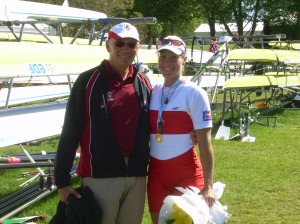
Lindsay with coach Mike Spracklen
Some people really criticize Mike for his aggressive attitude toward training when fatigued and in adverse conditions.
He’ll take us out in wind that’s stronger than what a sail boat would be happy to sail in, and it’s cold and raining and probably somewhat dangerous. There are days like that when you know you must not be rowing the best you can. I’ve heard some women say that in times like these, they could ‘get a better workout on the erg.’ I struggled with believing in that (the benefits of rowing in adverse conditions). I believed that there was some other, more valuable reason why we were braving the elements.
Mike said something after the world’s last year to the men that I wrote down because it epitomized what I was trying to understand about not missing workouts due to being tired or it’s being windy.
He said, “it’s not missing a session that loses the gold. It’s the psychology behind it. Don’t be happy to miss training. “
I thought, aha! That’s what I’ve been trying to define.
It probably isn’t negative on your physiology to take it in early because your back has a niggle, or the water isn’t perfect. But you’re weakening the mind. Those rows he leads us through are rows for our psychology; not our bodies.
If we can get through those, we can get through the Germans, the Brits, the Americans, etc. Or at least, that’s what we believe we can do, and that’s half the battle – maybe more. Our final (at the 2010 world championships) was rowed in the worst, raging head wind I have ever raced in.
Enough said.
Do you feel you train any differently with the men vs. the women?
Definitely.
The obvious thing is that the training program is entirely different. We do more steady state rows, that aren’t killing yourself, with the women. That’s positive because it gives you a chance to focus on what it is that you’re doing. I think it’s beneficial to row less fatigued and row really well, and to row really well when you are really fatigued because that’s when you make the biggest gains.
Another major difference is that with the women I have to be on my best behavior. With the men, anything’s fair game, and it all gets left on the water. It’s liberating really. But it’s also good to be made to act like a lady once in a while. Thanks girls!
Do you or did you feel the men treat you differently than they treat each other?
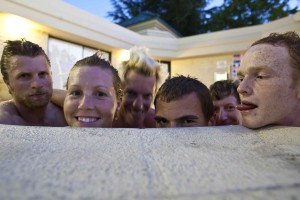
A little down-time with the heavyweights including Gabe Bergen, Lindsay, Steven Van Knotsenberg, Doug Csima and Will Crothers (Photo Kevin Light)
I think yes and no.
I end up in the back of the boat bay and there are pants being dropped like it’s any other male team mate back there. I laugh it off and tease them, but I take it as a compliment really. They all feel pretty comfortable around me and that really makes me feel part of the team.
The ways they treat me different are few. The most flattering and encouraging is that I really feel that most of them are 100% in my corner. They cheer me on in pieces when they finish first, and I always get a sense that they truly want to see me succeed and do well. That’s a great feeling and it’s not something you can really expect from the women because at the end of the day, until we’re in a boat together, we are each other’s competitors. The men are and always will be my team mates first.
One last question: any stories you’d like to share about training with the men? Particularly leading up to the last Olympics or next?
I have a general observation to share.
I am probably the only non-heavyweight, non-male rower that has seen first-hand what these guys do every day. They have wives, girlfriends, family and other teammates that get glimpses of their days. Some hear about it and understand really well; others not so much. I feel like I know what went into that silver and gold medal from Beijing.
I can say without a glimmer of apprehension that those men worked harder than anyone I know for what they accomplished. The work ethic, the focus, and the dedication on the men’s team is unmatched. I know their 2010 results did not reflect what I am describing, but you’re going to see them leading some races this year and next. I know it!
My time (training) with these guys is scarily drawing to an end, but they have all taught me so much about being tough and relentless. No matter where my training takes me over the next 15 months, they will be with me.
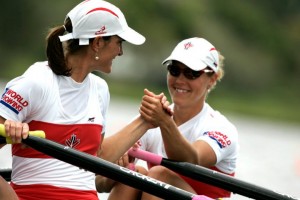
2010 LW2X world champions Lindsay Jennerich and Tracy Cameron (Photo Kevin Light)
Thanks for sharing, Lindsay.
Follow Lindsay Jennerich on her blog, Join the Journey at www.lindsayjenner.blogspot.com.
Comments
Got something to say?
